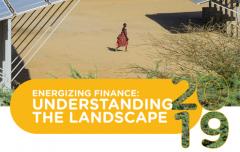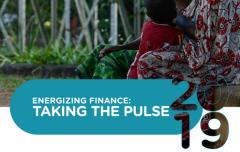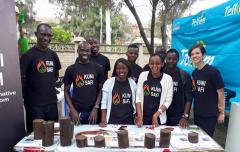Lack of clean cooking access: the 'other' public health crisis we cannot ignore
In the cold light of a COVID-19 world, we might well lose sight of another insidious public health crisis that kills an estimated 4 million people annually and whose adverse climate impacts include annual emissions equivalent to those of the global aviation industry. Unlike the response to COVID-19, no economic stimulus has been thrown at this crisis.
Around 3 billion people worldwide have no access to clean fuels or technologies for cooking, relying instead on burning biomass or solid fuels on open fires or in inefficient stoves. The consequences include deforestation, black carbon emissions and widespread human exposure to harmful indoor air pollution. Women and children, who are most often responsible for wood collection and cooking, carry a disproportionate share of the burden.
An estimated USD4 billion in annual investment is needed to achieve the Sustainable Development Goal 7 (SDG7) target of universal access to clean fuels and technologies for cooking by 2030. So just how much finance is committed to help achieve this goal? In 20 countries with some of the world’s highest clean cooking access deficits, a cumulative USD32 million was invested in clean cooking solutions in 2017. Yes, you read that right: USD32 million.
One word sums up aggregate financial commitments to date for widespread deployment of clean cooking solutions: abysmal. The amount of finance allocated to an issue imperative to the global community achieving numerous SDGs—health, gender equality, climate action, sustainable energy and more—is equivalent to a professional footballer’s annual salary.
A consequence of the dearth of finance available to support the clean cooking sector is the strain it places on the relatively few companies providing solutions. This is exemplified by the announcement last week that Rwanda-based Inyenyeri is going into liquidation.
Inyenyeri’s innovative approach to building a clean cooking fuel utility attracted early stage investors and earned the company an impressive customer following. But ultimately it was unable to raise the growth capital needed to scale its business.
The entrepreneurial challenge of raising capital in small and medium-sized businesses is a perennial one and no more so than during the current COVID-19 crisis, with liquidity constrained and global supply chains suspended. Even so, we can only hope that Inyenyeri’s experience will be a salutary one.
Tracking finance for clean cooking
The inadequacy of clean cooking finance globally was uncovered by Sustainable Energy for All (SEforALL) in the Energizing Finance 2019 research series, which tracked finance commitments for electricity and clean cooking access in 20 developing countries based on best available data.
A key takeaway from Energizing Finance 2019 is that meeting SDG7 targets requires a paradigm shift in how the global community approaches finance for clean cooking. A holistic approach that addresses the full value chain for demand and supply of solutions is urgently required because incremental approaches have not worked.
In other words, we need to build big markets for clean cooking solutions, and this calls for major financial and political commitment from the public and private sectors. Energizing Finance offers recommendations for how to build 'systems' of finance for clean cooking.
A crucial role for international public finance
The clean cooking sector is nascent, which means it requires grants and concessional funding to stimulate market demand and foster private sector engagement in supply. International public finance is the primary source of grant, concessional and high-risk capital for the sector’s development. Despite its catalytic role, according to Energizing Finance: Understanding the Landscape 2019, international public finance is declining—from 92 percent of all clean cooking finance tracked in 2015-2016 to 33 percent in 2017.
Realistically, domestic markets for clean cooking solutions are unlikely to scale without public finance to help alleviate risk for private sector investors and enterprises, and to stimulate demand. Given clean cooking’s overlap with and impact on numerous SDGs, development finance institutions (DFIs) are critical to facilitating universal access to solutions.
The World Bank’s new USD500 million Clean Cooking Fund and the Green Climate Fund’s USD20 million commitment to support the Global Clean Cooking Programme – Bangladesh are welcome developments. A core group of bilateral government funders, impact investors and philanthropies are also capitalizing the sector. But in view of the sheer magnitude of the financing gap, public climate and development finance has a more prominent role to play.
Domestic policy reform and investment
DFIs’ prioritization of clean cooking must be met with a similar show of commitment from national governments. Policy frameworks need to be reviewed and remade to enable sustainable deployment and adoption of clean cooking solutions, and governments must support the sector’s development through the value chain.
Nepal is one of the countries studied in Understanding the Landscape 2019. The report highlights how approximately 77 percent of Nepal’s energy is supplied by traditional biomass, including fuelwood, animal dung and residues, largely to meet residential demand for cooking. This reliance contributes to an estimated 8,700 deaths per year as a result of exposure to indoor air pollution.
However, the Government of Nepal has shown political will and engaged in targeted policy reform to facilitate increased deployment of clean cooking solutions in Nepali households. The government has established clear clean cooking targets within the framework of its 2018-2028 “Energy Decade” announcement, supporting the country’s improved Regulatory Indicators for Sustainable Energy (RISE) score of 73 (out of 100). Quantitative targets include the installation of 475,000 improved cookstoves and 131,200 biogas digesters by 2030, as set out in the Government’s National Rural and Renewable Energy Programme. Nepal’s first Nationally Determined Contribution includes a target to “equip every household in rural areas with smokeless (improved) cooking stoves by 2030”—a commendable goal in view of Nepal’s challenging mountainous terrain.
Meanwhile, the Alternative Energy Promotion Centre (AEPC) has been successful in supporting the deployment of more than 1.3 million improved cookstoves, 400,000 biogas plants, and around 600 solar cookers throughout Nepal. AEPC also implements the Government’s Renewable Energy Subsidy Policy, which includes clean cooking solutions.
Expanding available AEPC subsidies for clean cooking technologies and fuels, and raising international awareness of the availability of these subsidies, should attract a broader mix of solutions, companies and investment to Nepal’s clean cooking sector.
Addressing affordability gaps
The Nepal case study demonstrates the importance of subsidies in alleviating supply-side constraints for clean cooking solutions. However, a case study of Madagascar for Energizing Finance: Taking the Pulse 2019 highlights the need to also address barriers to wider clean cooking uptake on the demand side, specifically costs borne by consumers.
In Madagascar, less than 1 percent of the population—approximately 26.3 million people and 6.2 million households—used improved cookstoves (ICS) in 2017. Taking the Pulse 2019 forecasts that by 2030, 90 percent of Madagascar’s population will not be able to afford an ICS, putting the goal of universal clean cooking access out of reach. If consumers cannot afford an ICS there is effectively no demand for these stoves or clean fuels, which means clean cooking businesses are discouraged from investing in local markets.
To foster market growth, governments should consider subsidies to address consumer affordability gaps, to support a transition from traditional cooking methods to cleaner solutions. Taking the Pulse 2019 forecasts a cumulative USD217 million in consumer subsidies would be required to close the affordability gap for ICS in Madagascar by 2030.
Similar schemes have been implemented in India and Indonesia, leading to impressive gains in clean cooking access. These countries have experimented with direct cash transfers to consumers for the purchase of LPG kits (i.e. cylinders, hosing and stoves) as well as subsidizing lower-income households to enable them to buy LPG to use as cooking fuel.
Such measures must be matched with consumer awareness campaigns that promote clean cooking solutions, since many households will not be familiar with alternatives to their existing cooking practices or may need to be persuaded of the benefits.
As reflected in 2019’s Energizing Finance research findings, many countries with large clean cooking access deficits—including Madagascar and Nepal—have set ambitious targets for closing these gaps by 2030.
Success hinges on catalytic public finance, enabling domestic policies that support sustainable clean cooking value chains, and consumer support that promotes demand. This combination can crowd-in private sector involvement from a variety of investors and businesses, leading to more sustainable markets for clean fuels and cookstoves.
Photo credit: Inyenyeri





